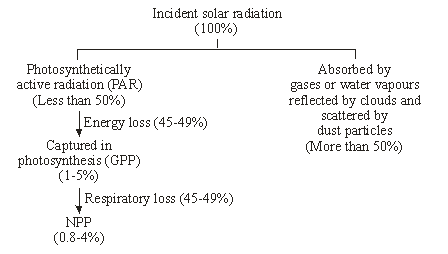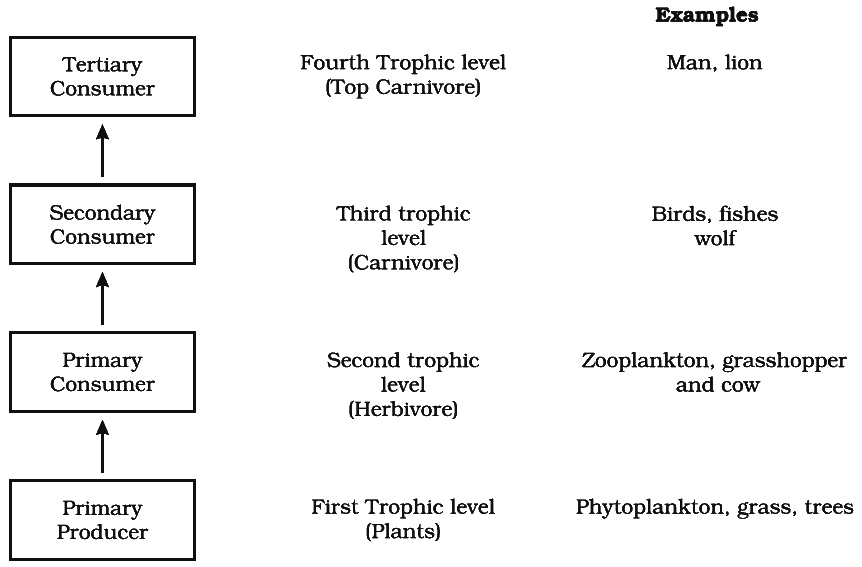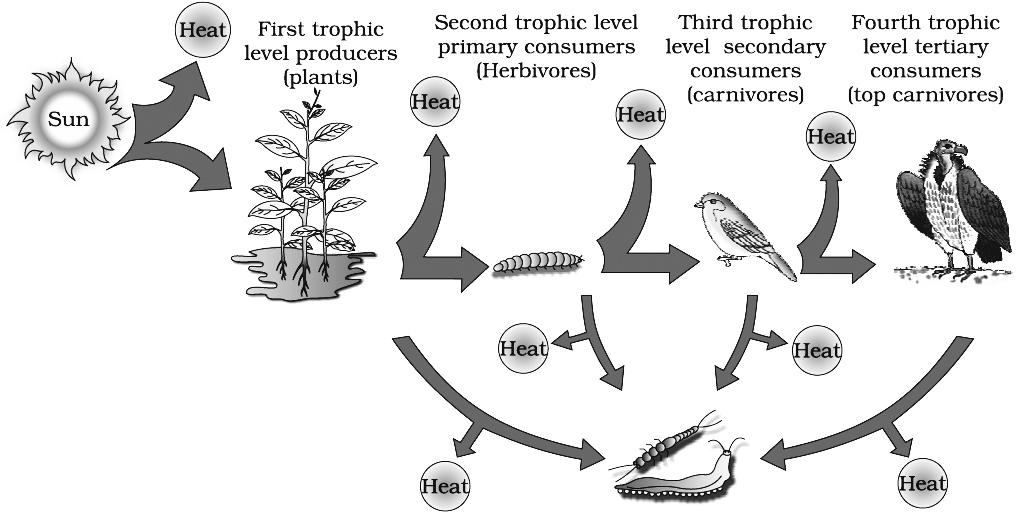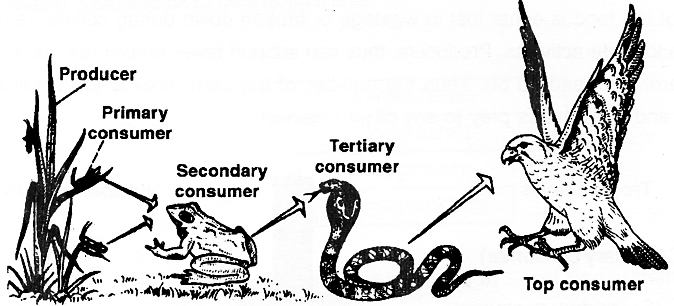- Books Name
- A TEXT OF BIOLOGY - CLASS XII
- Publication
- ACME SMART PUBLICATION
- Course
- CBSE Class 12
- Subject
- Biology
Energy Flow
Flow of incident energy is shown below

 It means plant capture only 2-10% of the PAR and this small amount of energy sustains the entire living world. All organisms depends upon plants (directly or indirectly) for energy.
It means plant capture only 2-10% of the PAR and this small amount of energy sustains the entire living world. All organisms depends upon plants (directly or indirectly) for energy.
Food Chain
It is a sequence of living organisms due to interdependence in which one organism consumes another.
Trophic Level :
Organisms occupy a place in the natural surroundings or in a community, according to their feeding relationship with other organism.
Every position is called trophic level.
It is based on the source of their nutrition.
The ultimate source of energy used by all living organisms is the sunlight which is entrapped by green plants, and utilized for the synthesis of complex organic substances (carbohydrates) during photosynthesis.
The energy trapped in organic substances by autotrophs is passed on to different living organisms through food.
Exchange of both energy and materials thus occurs through food.
The sequence of populations or organisms or trophic levels in an ecosystem through which food and its contained energy flows constitutes a food chain.
The number of trophic levels in a food chain is equal to the number of steps involving the transfer of food from one organism to the other.
Decomposers are not included in food chain as they operate at all trophic levels.
1. Producers: They are autotrophs, synthesizing complex organic substances from simple inorganic substances like CO2 and H2O during photosynthesis. The sunlight provides the energy for the process, the solar energy is converted into chemical energy and is stored in different complex organic substances like carbohydrates, proteins, lipids, etc.
2. Consumers: They are heterotrophic organisms incapable of synthesizing their own food. They depend upon plants (producers) for their food requirement directly or indirectly. The consumers are of different types:
(i) Primary consumers: They are herbivores which feed upon plants or plant products, e.g., rabbit, deer, field mouse, cow, elephant, small fish, tadpoles, several insects, zooplanktons like Paramecium, Daphnia, etc. These are called Key industry animals as they convert plant matter into animal matter.
(ii) Secondary consumers : They do not feed upon plants directly; instead feed upon herbivores, so are primary carnivores e.g., fox, jackal, frog, fish, several birds, etc.
(iii) Tertiary consumers: They are larger camivores which feed upon smaller carnivores e.g., wolf feeding upon fox, snake feeding on frog. These carnivores may also become prey to still larger carnivores. The latter are termed top carnivores e.g., tiger, lion, shark, crocodile, eagle, etc. A food chain may vary in length but usually consists of 4 or 5 steps or trophic levels. A few common food chains are given below :

Types of Food Chain
(i) Grazing Food Chain (GFC)/predator food chain
(a) Major conduit for energy flow in aquatic ecosystems.
(b) Always begins with producers
(c) Sun is the only source of energy
(d) Size of organisms commonly increase at higher trophic levels

(ii) Detritus Food Chain (DFC)
Death of an organism is the begining of DFC.
(a) In terrestrial ecosystems, a much larger fraction of energy flows through the DFC than through the GFC.
(b) Source of energy is detritus not sun.
(c) Composed of a long chain of detritus eating organisms (detritivores)
(d) In some ecosystems (e.g., Tropical rain forest) more energy flows in this chain than grazing food chain.
(e) DFC may be connected with the GFC at some levels, as some of the organisms of DFC are prey to certain GFC animals and in a natural ecosystem, some organisms like cockroaches, crows etc. are omnivores.
(iii) Parasitic food chain/Auxiliary food chain
Size of the organisms finally reduces at higher trophic level (parasite).
e.g., Tree herbivore birds lices and bugs.
Terrestrial food chains
1. Grass Rabbit Cat Wolf Tiger
2. Grass Grasshopper Frog Snake Peacock Falcon.
3. Vegetation Insect Predator bird Hawk.

3. Secondary consumer-Frog 4. Tertiary consumer-Snake 5. Quaternary top consumer-Eagle.
Aquatic food chains
1. Phytoplanktons Zooplanktons Crustaceans Predator insects Small fish Large fish.
2. Phytoplanktons Zooplanktons Crustaceans Predator insects Kingfisher Stork.
Food web
In ecosystem, linear food chains as shown above seldom exist, because every organism has alternate source of food.
An animal may have preference for a particular prey, but if the latter has a small population, it may feed upon some other prey.
Single animal may be eaten by different animals and thus different food chains get interconnected and one animal may be a link in more than one food chain.
The network of interconnected food chains at different trophic levels in a biotic community is termed food web.
Occurence of food webs provides stability to ecosystem.
Food webs operate because of taste preference for particular food and unavailability of food.
One animal may feed upon organism of ever different trophic level like -Snakes may feed upon mice (herbivore) and frogs (carnivore), jackals are both carnivores and scavengers.
Only 10% of the gross productivity of producers is entrapped by herbivores for their body building.
Similarly 10% of the herbivore productivity is available for raising productivity of primary carnivores.
Higher carnivores are also able to retain only 10% of energy present in primary carnivores.
It is called 10% law (Lindemann, 1942).
It is due to this fact, the number of trophic levels in the GFC is restricted as the energy transfer follows this law.
Respiratory loss gradually increases in successive trophic levels. It is 20%, 30% and 60% respectively at producer, consumer and top carnivore level.
Standing State or Standing Quality: Amount of all the inorganic substances present in an ecosystem per unit area at a given time.
Standing Crop: Amount of living material present in different trophic levels at a given time. It is commonly expressed as the number of organisms per unit area.

 ACME SMART PUBLICATION
ACME SMART PUBLICATION
